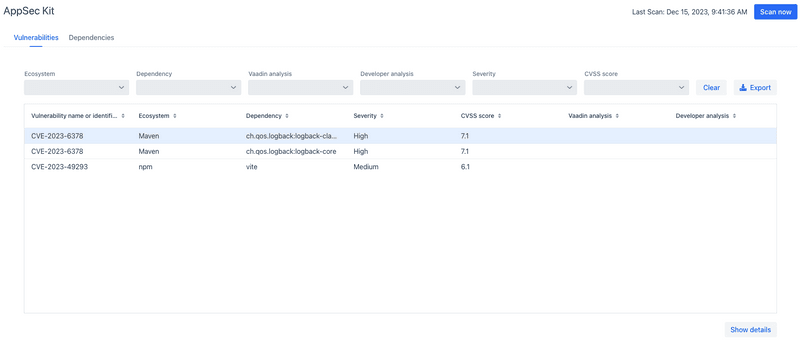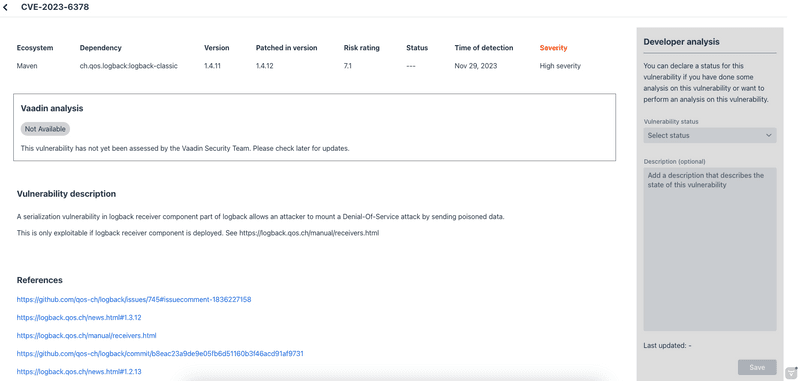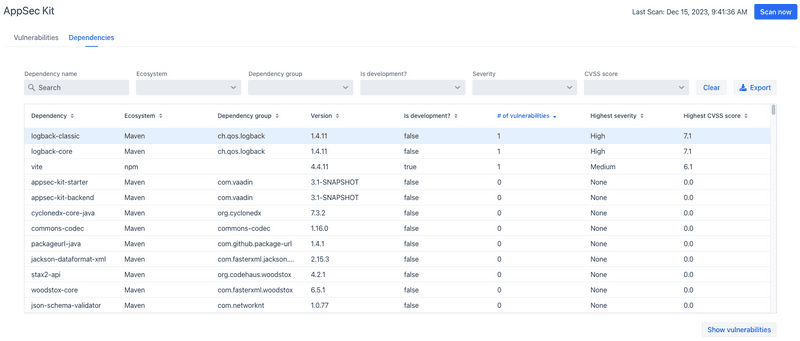Getting Started with AppSec Kit
AppSec Kit is an excellent tool for monitoring an application’s dependencies for vulnerabilities. It lets you see details of what’s discovered. And you can record and store your own analysis to share with other developers.
Add AppSec Kit Dependency
To start, you’ll need to add AppSec Kit as a dependency to your application. To add it to a Maven project, you might include something like this in the pom.xml file:
<dependency>
<groupId>com.vaadin</groupId>
<artifactId>appsec-kit-starter</artifactId>
<version>3.0.0</version>
</dependency>See the AppSec Kit releases page for the latest version, or for a different version of the dependency.
Generating SBOM Files
To be able to monitor the application dependencies, AppSec Kit needs the Software Bill of Materials (SBOM) files generated from Maven and npm dependencies. These files contain information about the dependencies and their transitives.
Maven Dependencies
To generate the SBOM file from Maven dependencies, you’ll need to add the CycloneDX Maven Plugin to the plugins in your pom.xml file like so:
<plugin>
<groupId>org.cyclonedx</groupId>
<artifactId>cyclonedx-maven-plugin</artifactId>
<version>2.7.7</version>
<executions>
<execution>
<phase>generate-resources</phase>
<goals>
<goal>makeAggregateBom</goal>
</goals>
</execution>
</executions>
<configuration>
<projectType>library</projectType>
<schemaVersion>1.4</schemaVersion>
<includeBomSerialNumber>true</includeBomSerialNumber>
<includeCompileScope>true</includeCompileScope>
<includeProvidedScope>true</includeProvidedScope>
<includeRuntimeScope>true</includeRuntimeScope>
<includeSystemScope>true</includeSystemScope>
<includeTestScope>false</includeTestScope>
<includeLicenseText>false</includeLicenseText>
<outputReactorProjects>true</outputReactorProjects>
<outputFormat>json</outputFormat>
<outputName>bom</outputName>
<outputDirectory>${project.build.outputDirectory}/resources</outputDirectory>
<verbose>false</verbose>
</configuration>
</plugin>Before starting the application, be sure to run the maven install. The plugin is configured to generate the SBOM file, bom.json in the /resources sub-directory in the project’s output directory.
npm Dependencies
Because of the pre-compiled frontend bundle, which is enabled by default, no frontend libraries are downloaded or compiled and there is no package.json file in the project. If you use the pre-compiled frontend bundle, you can skip this step because AppSec Kit uses the bundled npm SBOM from Vaadin. It does the vulnerability scan based on that.
If you disable the pre-compiled frontend bundle, a package.json file is generated in your project — or you can create your own file.
To generate the SBOM file from npm dependencies defined in the package.json file, you’ll need to run the @cyclonedx/cyclonedx-npm plugin with npx like so:
npx --package @cyclonedx/cyclonedx-npm --call exitThe @cyclonedx/cyclonedx-npm plugin requires node >= 14 and npm >= 6 versions. Also, the package-lock.json file and the node_modules folder should be present in order to run successfully.
To add it to the plugins, you would use the exec-maven-plugin in your pom.xml file like this:
<plugin>
<groupId>org.codehaus.mojo</groupId>
<artifactId>exec-maven-plugin</artifactId>
<version>1.3.2</version>
<executions>
<execution>
<id>cyclonedx-npm</id>
<goals>
<goal>exec</goal>
</goals>
<phase>generate-resources</phase>
<configuration>
<executable>npx</executable>
<arguments>
<argument>@cyclonedx/cyclonedx-npm</argument>
<argument>--output-file</argument>
<argument>${project.build.outputDirectory}/resources/bom-npm.json</argument>
<argument>--output-format</argument>
<argument>JSON</argument>
</arguments>
</configuration>
</execution>
</executions>
</plugin>Before starting the application, be sure to run the npm install and mvn install. The plugin is configured to generate the SBOM file, bom.json in the /resources sub-directory in the project’s output directory. AppSec Kit scans this SBOM file for vulnerabilities, if it’s available.
External APIs
AppSec Kit calls external APIs to get vulnerabilities and a vulnerability analysis for Vaadin dependencies. Since these calls are required for a normal operation, they need to be accessible.
OSV (Open Source Vulnerability) API:
https://api.osv.dev/v1/querybatch
https://api.osv.dev/v1/vulns/
GitHub API:
https://api.github.com/repos/vaadin/flow/releases
Vaadin vulnerability analysis:
https://raw.githubusercontent.com/vaadin/vulnerability-analysis/main/analysis.jsonStart the Application
AppSec Kit isn’t enabled in production mode. You’ll need to start your application in development mode — which is the default mode in which applications start. You don’t need to enable this, explicitly.
Vaadin Development Tools
The Vaadin Development Tools has a few aspects of which you should be aware, but which might not be obvious. This section explains the user interface.
Notification Dialog
After the application has started, AppSec Kit analyzes the dependencies, collects any vulnerabilities, and displays a notification dialog through the Vaadin Development Tools (see screenshot). There you’ll see a link labeled Learn more that you can click to open the UI in a new tab.

AppSec Kit Tab
You can open the Vaadin Development Tools and navigate to the AppSec Kit tab where you can see the found new vulnerabilities count. A vulnerability is considered as new if a developer analysis has not been added to it yet. Therefore, vulnerabilities with developer analysis aren’t counted in the found vulnerabilities number.
There’s also a button labeled Open AppSec Kit that you can click to open the UI in a new tab.

You can also navigate to the UI using the vaadin-appsec-kit route. For example, on your localhost, enter this in your browser: http://localhost:8080/vaadin-appsec-kit.
AppSec Kit activates server push if neither push nor polling is active for a UI in which AppSec Kit is used. It does this so you’ll be notified when new vulnerabilities are found. You can disable this functionality by overriding the default AppSec Kit configuration.
Vulnerability Alert
When AppSec Kit finds vulnerabilities, it shows an alert pop-up concerning it. This pop-up disappears after a while.

When the alert pop-up disappears, the same message appears in the log feed under the Log tab.

If AppSec Kit doesn’t find any vulnerabilities, it shows the "No vulnerabilities found" message in the AppSec Kit tab, the alert pop-up, and the log feed. If there hasn’t been a vulnerability scan yet, the "No data available yet" message is shown.
AppSec Kit UI
The AppSec Kit UI has views for seeing vulnerabilities and dependencies of which you should be aware. This section describes those views, which can be found under the two main tabs of the UI.
Vulnerabilities Tab
When you open the UI, you’ll see the Vulnerabilities tab (see screenshot). Any vulnerabilities found are listed there. They’re shown in a grid view, with columns to help identify them, and the ecosystem and the dependency in which each has been found. It also includes the severity calculated from the CVSS vector string, a CVSS score and some analyses.
You can filter vulnerabilities by using the Ecosystem, Dependency, Vaadin analysis, Developer analysis, Severity, and Common Vulnerability Scoring System (i.e., CVSS) score filters. You’d choose these filters from the pull-down menus near the top to apply them. Click on the Clear button next to the filters to reset them.
You can also export the list of vulnerabilities with the Export button to a file named vulnerabilities.csv.

To run a new scan, click the Scan now button at the top right corner. After it’s finished, the Last Scan date and time is updated — located also at the top right.
If you want to see more details about a particular vulnerability, select the row containing it, and then click the Show details button. Or you can double-click on the row. The Vulnerability Details View is then opened — which is described next.
Vulnerability Details
When you open a listed vulnerability, you can find a more detailed description of it (see the screenshot here). You’ll also find there links to other pages to explain the vulnerability and offer some general suggestions to resolve them.
If the Vaadin Security Team is reviewing the vulnerability, it’ll be noted at the top. This includes Vaadin’s specific assessment and recommendations related to the vulnerability.

On the right side of the Details View, there’s a Developer analysis panel. There you can set the Vulnerability status and add your own description and other information you’ve uncovered. Preserve what you enter by clicking the Save button. Your analysis is made available to other developers if you commit it to the version control system.
Dependencies Tab
To see your application dependencies, click the Dependencies tab at the top left of the UI. There you’ll find a list of dependencies in a grid view (see screenshot here).
They’re listed in columns to help identify each dependency, ecosystem, and group to which it belongs, and the version. It also lists the Is development, which marks if an npm dependency is a development dependency — for Maven dependencies this is always false. And it lists the count of vulnerabilities, the highest severity, and the highest CVSS score.

You can filter the list of dependencies based on the Dependency name, Ecosystem, Dependency group, Is development, Security, and the CVSS score. Choose these filters from the pull-down menus near the top to apply them. Click on the Clear button to reset them.
You can also export the dependencies with the Export button into a file named dependencies.csv.
If you want to see the vulnerabilities of a particular dependency, select the row containing it, and then click the Show vulnerabilities button. Or you can double-click on the row. The Vulnerabilities Tab is then opened with the vulnerabilities for that dependency.